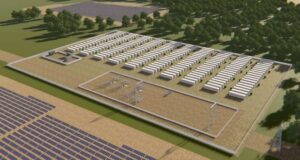The soon-to-be-announced investment in expanding the Tesla big battery at the Hornsdale Power Reserve in Australia will not just be about making the world’s biggest lithium ion battery bigger – it will also be about performing new tricks, and delivering new services to the Australian grid.
The Tesla battery at Hornsdale is already the world’s biggest lithium-ion installation at 100MW/129MWh, although that ranking is under threat from other batteries proposed for US markets, and for Australia (although some of them might be at least a year away from construction).
The evidence from video footage of trucks carrying hundreds of Tesla Powerpacks to the Hornsdale facility, and the earthworks being undertaken there, suggest an increase in capacity of at least 50 per cent.
But when it is announced – and RenewEconomy understands it will be Tuesday – it will not just be about doing more of what it currently delivers (which is system security under a $4 million a year contract with the state government; playing in the frequency and ancillary services market, where it earns most of its revenue; and the energy spot market where it buys at low prices and sells at peak prices).
RenewEconomy understands that the Australian Renewable Energy Agency is also involved in the new development, in a funding capacity, which indicates that the Hornsdale battery will be delivering new and additional services. (That is ARENA’s main criteria for such investments).
This could, in theory, be any number of possibilities, given that grid-scale batteries are said to be capable of delivering about 20 different functions, many of them not recognised by the market because the regulators and rule-makers don’t yet understand what they can do and why.
None of the parties involved – Tesla, Neoen (which owns and operates the Hornsdale facility), the South Australia government, and ARENA – would comment ahead of the announcement which apparently is coming soon.
But one distinct possibility is providing “digital inertia” that could help maintain system strength. This would be a much needed addition to the grid, particularly with more wind and solar entering the market, or at least wanting to enter the market, and more “synchronous” generation (i.e. coal and gas) likely to leave.
Currently many wind and solar installations have been “constrained” by system strength issues, and many others have been required by the market operator or local network owner to install their own “synchronous condensers” to help maintain system strength.
This has been criticised for a number of reasons. One is a lack of co-ordination, cited by the likes of Transgrid and other energy specialists, who say the indiscriminate and unplanned installations might actually be make the system less secure rather than more secure.
The other is that synchronous condensers are 50-year old technology. Which does not mean that they don’t work, just that there is probably a cheaper and smarter idea, and if batteries can provide that service, and do a lot more other things at the same time, then that would be an obvious solution.
South Australia, of course, is a leader in wind and solar installations and it already accounts for a world-leading share of more than 50 per cent – heading to “net 100 per cent” by around 2030.
It, unlike other states, has a co-ordinated plan to install synchronous condensers at four different locations, meaning it will not have to rely on gas generators to deliver that service. But it may decide it needs more inertia, and from more modern and cheaper sources.
A recent presentation by battery storage developer Fluence – a rival to Tesla which has provided the technology for the Ballarat system and the soon-to-be-opened Lincoln Gap installation – says batteries could deliver huge savings in inertia costs.
It cited a recent study from Ireland that suggested battery-based energy storage is very capable of satisfying system operator inertia requirements, and that 360MW of battery-based energy storage could provide the equivalent stabilisation as would normally be provided by 3,000MW of conventional thermal generation.
And in Ireland, a shift to batteries providing inertia could save up to €19 million ($A31 million) annually and could achieve approximately 1.4 million tonnes of annual CO2 savings.
To do this in Australia, it will need some demonstration to show how the technology works, and how market mechanisms or signals can be adapted or created to provide an incentive for more investment.
Chances are that it could be something else – so called grid forming or islanding capabilities – but this seems a likely choice.
Note: RenewEconomy understands that energy minister Angus Taylor is not attending the announcement, even though it includes ARENA funding.
Update: The story is confirmed by the announcement on Tuesday: Tesla big battery adds new capacity and services on march to 100pct renewables grid










